How to Boost Online Sales in 2025: Top Strategies
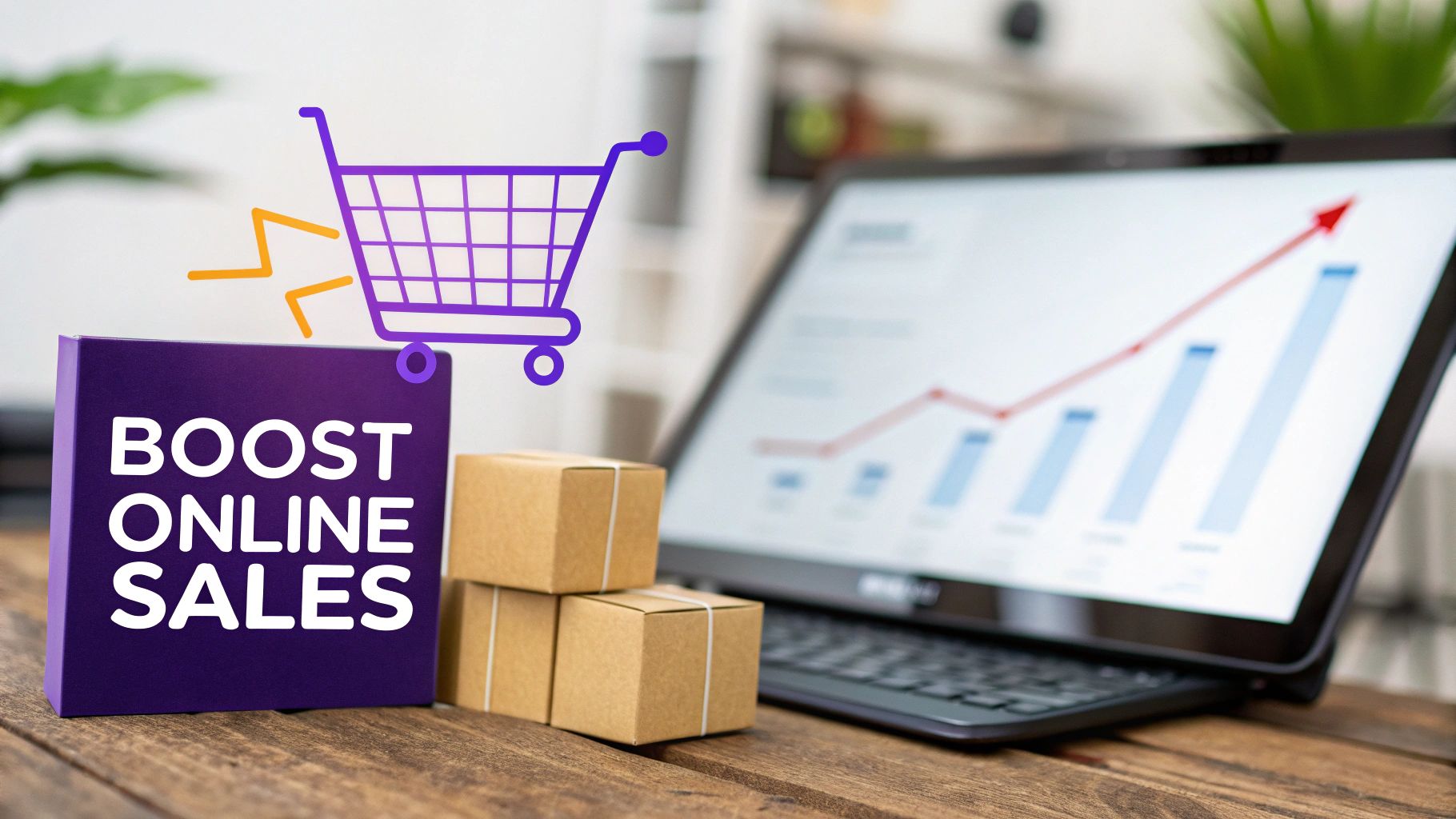
Skyrocket Your Sales: Proven Strategies for 2025
Want to boost online sales and take your e-commerce business to the next level? This listicle delivers seven proven strategies to increase conversions and maximize revenue in 2025. We'll cover essential tactics like conversion rate optimization (CRO), personalized marketing, mobile optimization, social commerce integration, customer retention programs, content marketing, and abandoned cart recovery. Whether you're an established Etsy seller or running a growing e-commerce website, these actionable tips will help you attract more customers and boost your bottom line. Let's get started!
1. Conversion Rate Optimization (CRO)
Conversion Rate Optimization (CRO) is the secret weapon for boosting your online sales without necessarily spending more on advertising. It's the systematic process of tweaking your website to persuade more visitors to take the actions you want them to take – like adding items to their cart and completing a purchase. Think of it as fine-tuning your online store to create a smoother, more enticing shopping experience. For e-commerce businesses, this means optimizing crucial elements such as product pages, the checkout process, and calls-to-action to convert more browsers into buyers. Instead of throwing more money at attracting new customers, CRO focuses on maximizing the potential of the traffic you already have.
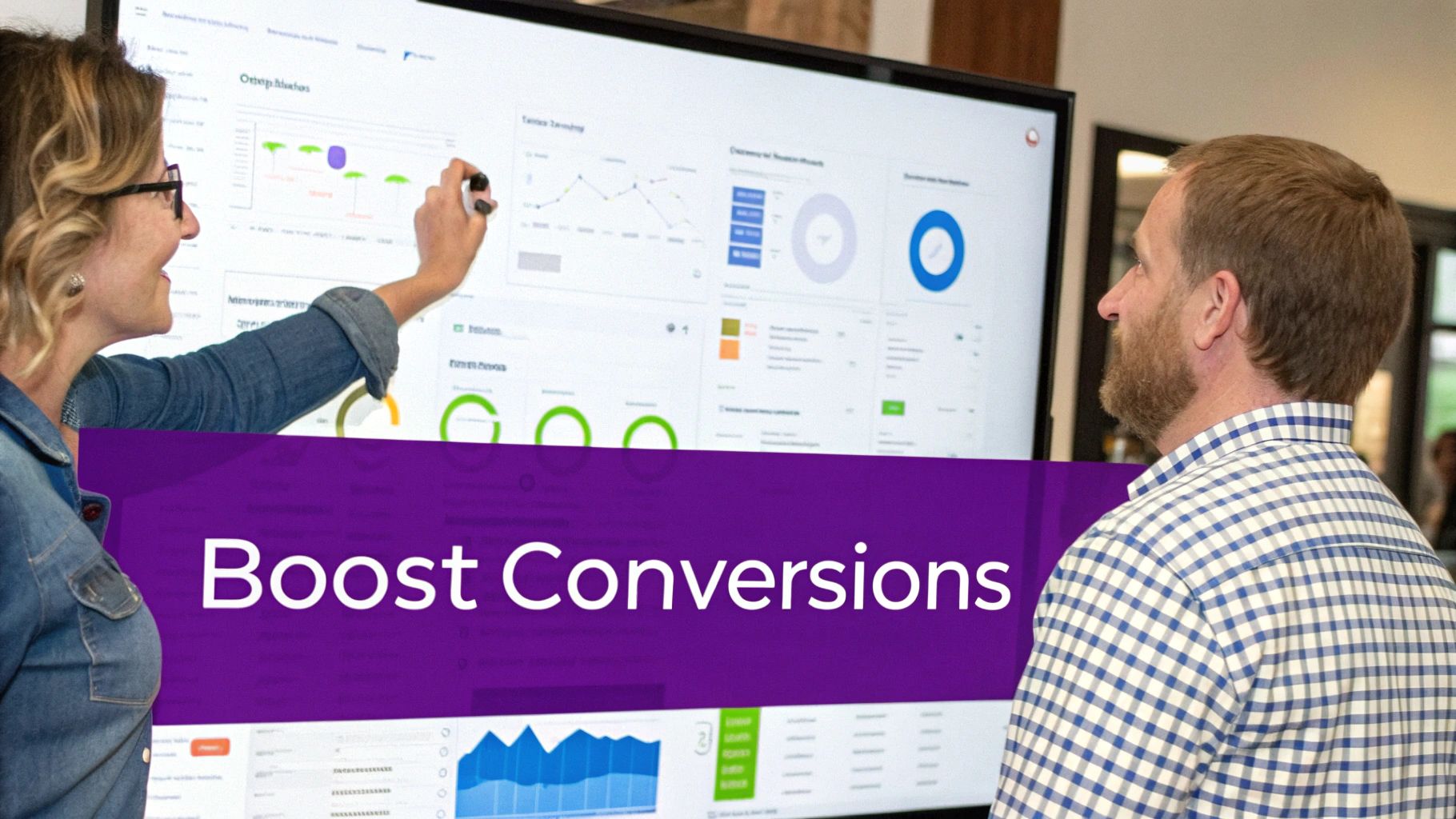
For Etsy shop owners hitting $10k/month or e-commerce businesses in the $20k-$60k/month range, CRO is especially powerful. You already have a proven product and a customer base, but likely have untapped potential within your existing website traffic. By optimizing your conversion rate, you can significantly increase revenue without a corresponding increase in advertising costs. Conversion rate optimization is crucial for boosting sales. For practical, actionable strategies on driving sales growth, check out this comprehensive guide: how to increase online sales from CartBoss.
CRO leverages a variety of techniques, including:
- A/B Testing: Comparing two versions of a webpage element (e.g., a button color or headline) to see which performs better.
- User Experience (UX) Improvements: Making your website easier and more enjoyable to navigate.
- Analytics-Driven Decision Making: Using data from tools like Google Analytics to identify areas for improvement.
- Multivariate Testing: Testing multiple variations of several page elements simultaneously.
- Funnel Analysis: Identifying drop-off points in the customer journey (e.g., abandoned carts) and optimizing those steps.
Why CRO Deserves Its Place on the List:
CRO focuses on making the most of what you already have. It's about working smarter, not harder. By optimizing your existing traffic, you can see a significant return on investment without increasing your ad spend.
Pros:
- Improves ROI from existing traffic
- Data-driven approach reduces guesswork
- Typically offers high returns compared to investment
- Compounds with other marketing efforts
Cons:
- Requires significant testing to see results
- Need for specialized knowledge or tools
- Can be time-consuming to implement properly
- Requires sufficient traffic volume for statistical significance
Examples of Successful CRO:
- Booking.com: Runs thousands of A/B tests yearly, constantly optimizing conversion elements.
- Amazon: The 1-Click ordering system drastically increased conversions by simplifying checkout.
- Shopify: Increased sales by 17% by streamlining their checkout process after CRO analysis.
Actionable Tips for You:
- Focus on highest-traffic pages first: Start by optimizing the pages that get the most views.
- Test one element at a time for clear results: This allows you to isolate the impact of each change.
- Analyze user recordings to identify friction points: See how users interact with your website and identify areas where they get stuck.
- Prioritize mobile optimization: Mobile traffic is crucial; ensure your website is mobile-friendly.
- Use heat maps to understand where users focus attention: This helps you optimize the placement of key elements like calls-to-action.
By implementing CRO strategies, you can transform your website into a high-performing sales machine, driving significant growth and boosting your bottom line.
2. Personalized Marketing and Product Recommendations
In the competitive world of online sales, standing out and capturing customer attention is crucial for boosting your bottom line. One of the most effective strategies for achieving this is personalized marketing and product recommendations. This approach involves tailoring the shopping experience to each individual customer based on their behavior, preferences, purchase history, and demographics. Imagine walking into your favorite brick-and-mortar store and having the salesperson greet you by name and immediately guide you to items they know you'll love. That's the power of personalization online. It transforms the impersonal nature of e-commerce into a curated experience that resonates with each shopper, leading to higher conversion rates and increased average order values.
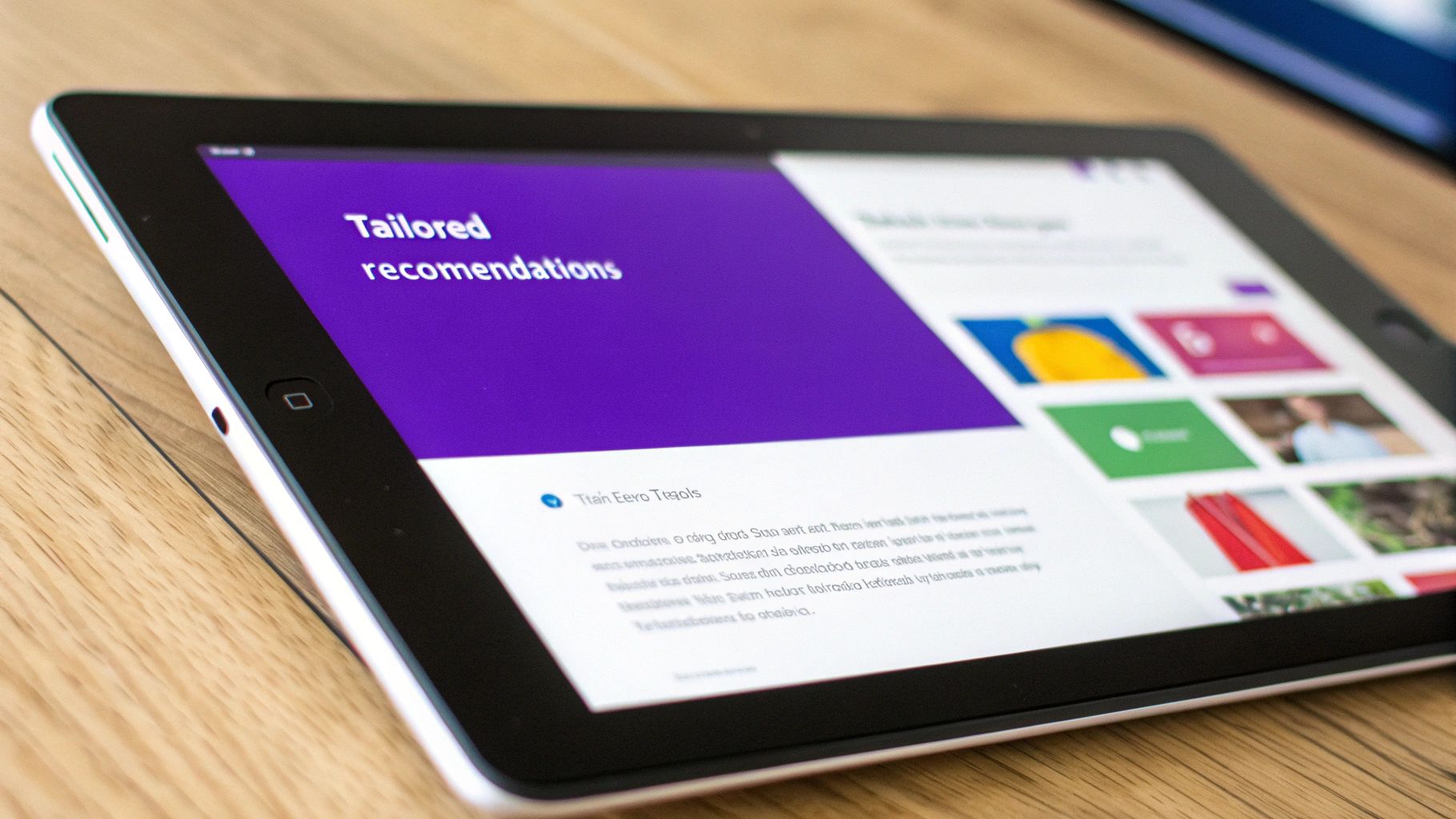
This strategy utilizes data and algorithms to display relevant products, content, and offers to each visitor. For Etsy shop owners pulling in $10k+ per month, e-commerce businesses in the $20k-$60k range, and those with websites ripe for improvement, personalization can be a game-changer. If you're already seeing traction, imagine the potential for growth by offering each customer a uniquely relevant experience.
Features of Personalized Marketing:
- AI-powered product recommendations: Leverage the power of artificial intelligence to suggest items customers are likely to be interested in based on their past browsing and purchase history.
- Dynamic content based on user behavior: Show different content blocks, banners, and promotions to different customer segments based on their real-time interactions with your website.
- Personalized email marketing campaigns: Send targeted emails featuring products, promotions, and content tailored to individual customer preferences and purchase history. No more generic blasts!
- Customized landing pages: Create landing pages specifically designed for different customer segments, ensuring a more focused and relevant experience.
- Behavioral targeting: Display ads and promotions to customers based on their past browsing behavior, even after they've left your website (retargeting).
The Benefits of Personalization:
- Increases Average Order Value (AOV): By suggesting complementary products or higher-value alternatives, you can encourage customers to spend more per transaction.
- Improves Customer Satisfaction and Loyalty: A personalized experience makes customers feel valued and understood, leading to increased satisfaction and repeat purchases.
- Enhances User Engagement: Relevant recommendations and targeted content keep customers engaged and browsing your website for longer periods.
- Creates a More Relevant Shopping Experience: Customers are presented with products and information that genuinely interest them, leading to a more satisfying and efficient shopping journey.
- Can Significantly Boost Conversion Rates: By showing the right products to the right people at the right time, you can dramatically increase the likelihood of a purchase.
Pros and Cons:
While personalization offers significant advantages, it's crucial to be aware of the potential drawbacks:
Pros: Increased AOV, improved customer satisfaction and loyalty, enhanced user engagement, more relevant shopping experience, boosted conversion rates.
Cons: Requires substantial customer data, privacy concerns and regulations (GDPR, CCPA), implementation can be technically complex, potential for algorithm biases.
Real-World Success Stories:
- Amazon: Generates 35% of its revenue from its personalized recommendation engine.
- Netflix: Saves $1 billion annually through personalized recommendations that reduce churn.
- Spotify: Discover Weekly personalized playlists dramatically increased user engagement.
- Sephora: Personalized beauty recommendations increased average basket size by 20%.
Actionable Tips for Your Business:
- Start Simple: Begin by personalizing emails with the customer's first name.
- Segment Your Customers: Group customers based on purchase history and browsing behavior to create targeted campaigns.
- Implement "Customers Also Bought" Recommendations: This is a simple yet effective way to increase AOV on product pages.
- Use Personalized Retargeting Ads: Reconnect with customers who abandoned their carts with tailored ads showcasing the items they left behind.
- Create Dynamic Content Blocks on Your Homepage: Display different featured products and promotions to different customer segments.
Personalization is no longer a luxury; it's a necessity for online businesses looking to thrive. By implementing these tips and embracing the power of personalized marketing, you can create a more engaging and profitable shopping experience for your customers and significantly boost your online sales. This approach deserves its place on this list because it directly addresses the core challenge of increasing conversions and AOV, two key metrics for any successful e-commerce business. Tools like Salesforce Commerce Cloud, Nosto, and Dynamic Yield can help you implement these strategies effectively, though starting small and building up is always a smart approach.
3. Mobile Optimization Strategy
In today's e-commerce landscape, ignoring mobile users is like leaving money on the table. With over 70% of e-commerce traffic coming from mobile devices in many sectors, a robust mobile optimization strategy is no longer a luxury—it's a necessity for boosting online sales. This means tailoring your online shopping experience specifically for smartphones and tablets to ensure seamless browsing, easy navigation, and a frictionless checkout process. For Etsy shop owners hitting $10k/month, established e-commerce stores in the $20k-$60k/month range, and anyone with a website showing traction but needing improvement, mobile optimization is a game-changer.
What is Mobile Optimization and How Does It Work?
Mobile optimization involves enhancing every aspect of your website for mobile users. This includes optimizing website speed, simplifying navigation, and streamlining the checkout process on smaller screens. It's about creating a user experience that's not just functional on mobile, but truly enjoyable. Think about how frustrating it is to pinch and zoom on a website that's clearly designed for desktop. That's the experience you want to avoid at all costs.
Key Features of a Mobile-Optimized Website:
- Responsive Web Design: Your site automatically adjusts its layout and content to fit different screen sizes.
- Mobile-First Development: Designing for mobile first and then scaling up to desktop ensures a superior mobile experience.
- Accelerated Mobile Pages (AMP): A Google-backed project that creates lightweight versions of web pages for faster mobile loading.
- Touch-Friendly Interface Elements: Buttons and links are large enough to be easily tapped with a finger. Remember the 44x44 pixel guideline!
- Progressive Web Apps (PWA) Capabilities: PWAs offer app-like experiences within the browser, improving engagement and functionality.
- Mobile Payment Integration: Seamless integration with mobile wallets like Apple Pay and Google Pay makes checkout a breeze.
Why Mobile Optimization Deserves its Place on This List:
Simply put, your customers are on mobile. If your site isn't optimized for their preferred browsing method, you're losing sales. Google also prioritizes mobile-friendly websites in its search rankings (mobile-first indexing), meaning a poor mobile experience can hurt your SEO.
Pros:
- Reaches the Growing Mobile Shopping Audience: Tap into the vast and expanding market of mobile shoppers.
- Improves SEO Rankings: Google rewards mobile-friendly websites with better visibility.
- Reduces Bounce Rates on Mobile Devices: A better user experience keeps visitors engaged and browsing.
- Enhances User Experience Across Devices: Provides a consistent and positive experience regardless of how customers access your site.
- Faster Loading Speeds Lead to Higher Conversion Rates: Nobody likes waiting for a slow website. Faster loading times directly translate into more sales.
Cons:
- Requires Ongoing Testing Across Multiple Devices: Ensuring compatibility across various devices and operating systems requires continuous testing.
- May Need Significant Redesign of Existing Sites: Older websites might need substantial overhauls to become truly mobile-friendly.
- Limited Screen Space Creates Design Challenges: Designing for smaller screens requires careful planning and prioritization of content.
- Mobile Payment Integration Can Be Complex: Integrating various mobile payment gateways can be technically challenging.
Examples of Successful Mobile Optimization:
- Alibaba: Increased mobile conversions by a staggering 76% after implementing PWA technology.
- ASOS: Saw a 50% increase in orders after optimizing their mobile checkout flow.
- Pinterest: Rebuilt their mobile site as a PWA and witnessed a 60% increase in user engagement.
- Walmart: Mobile optimization efforts led to a significant 20% increase in conversions.
Actionable Tips for Boosting Your Mobile Sales:
- Use Google's Mobile-Friendly Test: Identify areas for improvement on your site using this free tool.
- Implement Simplified Navigation for Mobile Users: Make it easy for customers to find what they're looking for with a clear and concise mobile menu.
- Ensure All Buttons are Thumb-Friendly: Aim for a minimum size of 44x44 pixels for all clickable elements.
- Optimize Images Specifically for Mobile Devices: Compress images to reduce loading times without sacrificing quality.
- Enable Autofill for Forms: Streamline the checkout process by allowing users to autofill their information.
- Test Load Times Using Google PageSpeed Insights: Identify and address any performance bottlenecks that are slowing down your mobile site.
By prioritizing mobile optimization, you're not just adapting to the current market; you're investing in the future of your e-commerce business. It's a crucial step for boosting online sales and reaching your full potential in the increasingly mobile-centric world of online shopping.
4. Social Commerce Integration
Want to boost online sales? Meet your customers where they already are: social media. Social commerce integration seamlessly blends your online store with popular social platforms, allowing customers to discover, research, and purchase your products without ever leaving their favorite apps. This streamlined approach reduces friction in the buying journey, capitalizing on impulse purchases and leveraging the power of social proof.
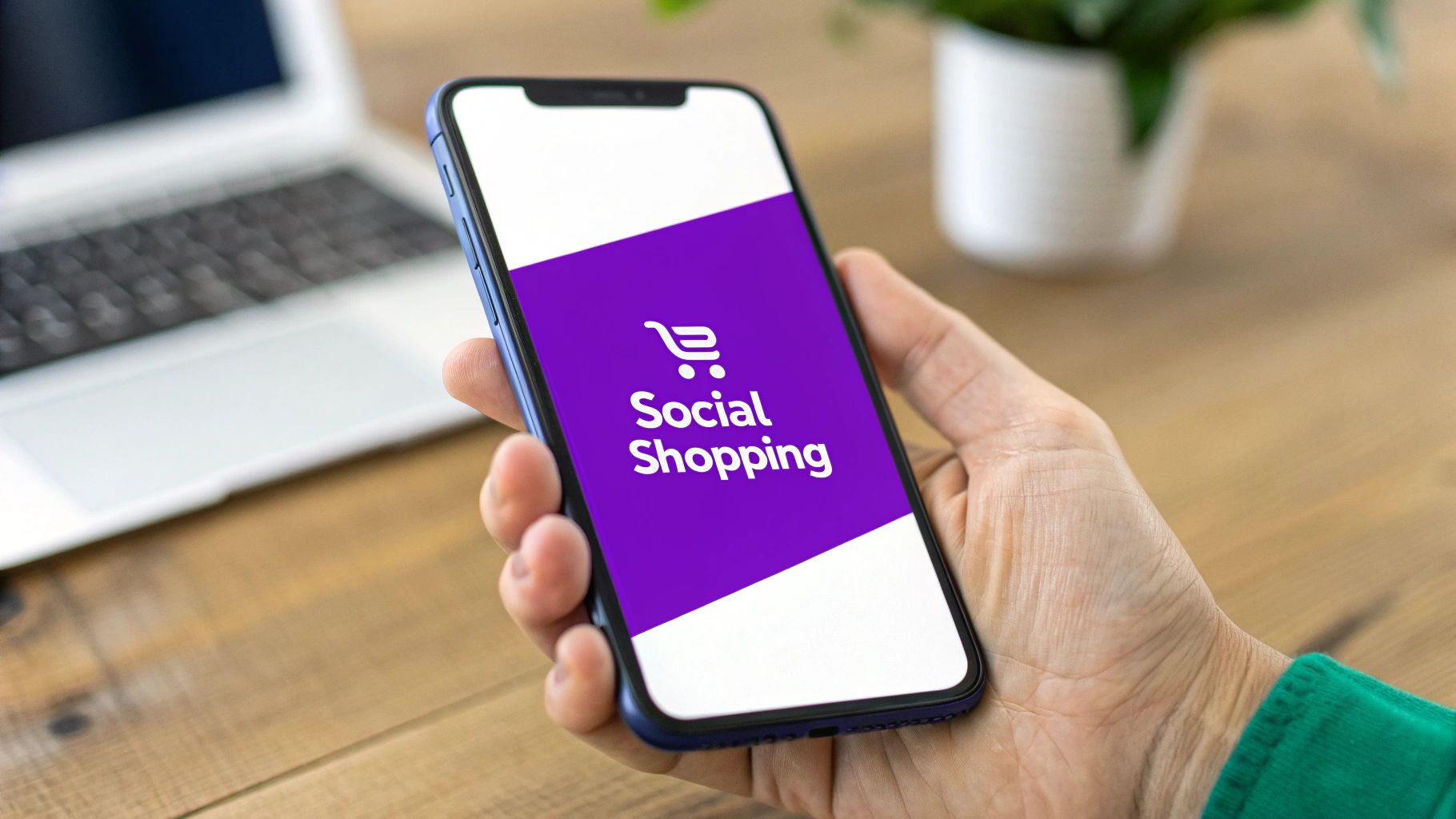
For Etsy shop owners hitting $10k/month, established e-commerce businesses in the $20k-$60k range, or those with websites needing a boost, social commerce offers significant advantages. Imagine shoppable posts on Instagram showcasing your handcrafted jewelry, or a Facebook Shop seamlessly integrated with your existing e-commerce platform. Features like Pinterest buyable pins, TikTok Shop functionality, and even live shopping events can open new avenues for revenue. Think of it as extending your storefront onto the bustling streets of social media.
This approach deserves a spot on this list because it directly addresses a key challenge in online sales: simplifying the customer journey. By enabling purchases within the social media environment, you eliminate extra steps and reduce cart abandonment. This is especially powerful for impulse buys – a customer scrolling through Instagram might see your product and buy it instantly, whereas directing them to an external website introduces opportunities for distraction and second thoughts.
Examples of Success: Social commerce isn't just a trend; it's a proven sales booster. Kylie Cosmetics famously generated $1M in revenue in one minute through Instagram shopping, demonstrating the platform's raw selling power. Brands like Allbirds and Glossier have also seen significant success leveraging social commerce to drive traffic and build their brands. Even in highly competitive markets like China, Perfect Diary rose to the top of the cosmetics industry through strategic social commerce on WeChat.
Actionable Tips for Your Business:
- Platform-Specific Content: Don't just repurpose content. Tailor your visuals and messaging to each platform's unique audience and format. High-quality, mobile-optimized visuals are crucial.
- User-Generated Content (UGC): Encourage customers to share their experiences with your products. UGC builds authenticity and trust, acting as powerful social proof.
- Consistent Posting with Shopping Opportunities: Regularly feature shoppable posts and stories, integrating them seamlessly into your content calendar.
- Influencer Marketing: Partner with relevant influencers to expand your reach and tap into their engaged audiences.
- Seamless Website Integration: Ensure a smooth transition between social platforms and your website for customers who want to explore further.
Pros and Cons:
Pros:
- Reduced steps in the purchase journey
- Capitalizes on impulse buying
- Leverages social proof
- Access to platform targeting capabilities
- Seamless discovery-to-purchase experiences
Cons:
- Platform dependency and algorithm changes
- Commission fees
- Limited customer data compared to owned websites
- Potential brand perception issues if over-promotional
- Varying shopping functionality across platforms
Social commerce integration is a powerful tool for boosting online sales. While it requires a dedicated strategy and consistent effort, the potential to reach new customers and streamline the buying journey makes it a worthwhile investment for businesses looking to scale. By understanding the nuances of each platform and implementing these tips, you can leverage the power of social commerce to drive significant growth for your business.
5. Customer Retention and Loyalty Programs: Turn One-Time Buyers into Lifelong Fans
Want to know a secret to boosting online sales that's often overlooked? It's not always about chasing new customers. It's about nurturing the ones you already have. Customer retention and loyalty programs are your secret weapon for turning one-time buyers into lifelong fans, and ultimately, boosting those all-important online sales. For Etsy shop owners pulling in $10k+ a month, growing e-commerce stores in the $20k-$60k range, and anyone with a website ripe for improvement, this is crucial for sustainable growth.
Building a loyal customer base is like cultivating a thriving garden. You need to nurture it, tend to its needs, and provide the right conditions for it to flourish. That's exactly what a well-designed loyalty program does. It fosters a sense of community, rewards engagement, and encourages repeat purchases, which is significantly more cost-effective (5-25x cheaper!) than constantly acquiring new customers.
How it Works: The Mechanics of Loyalty
Loyalty programs work by offering rewards and incentives to customers for their continued business. These rewards can take many forms:
- Points-based systems: Customers earn points for every purchase, which they can later redeem for discounts or free products.
- Tiered memberships: As customers spend more, they unlock higher membership tiers with escalating benefits, creating a sense of progression and aspiration. Think "bronze," "silver," and "gold" levels.
- Referral bonuses: Encourage your happy customers to spread the word by offering them rewards for referring new customers.
- Exclusive access: Grant loyal customers early access to new products, special sales, or limited-edition items.
- Personalized rewards: Leverage purchase history data to tailor rewards to individual customer preferences.
- Gamification: Incorporate game-like elements, such as challenges or badges, to make the program more engaging and fun.
Real-World Success Stories:
Big brands have mastered the art of loyalty. Look at Sephora's Beauty Insider program with its 25M+ members driving 80% of sales, or Amazon Prime's subscription model with its 200M+ global members. Even Starbucks Rewards accounts for a whopping 40% of the company's transactions. These programs demonstrate the power of loyalty to drive serious revenue. REI's Co-op membership model, offering lifetime benefits and annual dividends, further showcases how a strong loyalty program can build a dedicated community.
Actionable Tips for Your Online Store:
Ready to cultivate your own loyal following and boost online sales? Here's how:
- Focus on Emotional Connection: Don't just offer discounts. Craft a program that makes customers feel valued and appreciated. Offer exclusive content, personalized recommendations, or early access to sales.
- Simplicity is Key: Make earning and redeeming rewards straightforward and transparent. Complicated programs can frustrate customers and deter participation.
- Tiered Motivation: Design tiers that provide tangible benefits at each level and motivate customers to strive for the next.
- Data-Driven Personalization: Utilize the data gathered from your loyalty program to personalize marketing efforts and offer tailored product recommendations.
- Strategic Partnerships: Consider partnering with complementary brands to offer bundled rewards and expand your reach.
- Regular Evaluation: Continuously monitor your program's performance, gather customer feedback, and make adjustments to optimize its effectiveness.
Pros and Cons – Weighing the Balance:
While loyalty programs offer significant advantages, it's crucial to acknowledge the potential downsides:
Pros:
- Increases customer lifetime value (CLV) – more repeat business!
- More cost-effective than customer acquisition.
- Creates brand advocates who refer new customers.
- Provides valuable customer data and insights.
- Builds an emotional connection with your brand.
Cons:
- Program maintenance costs and complexity.
- Rewards can devalue over time if not managed carefully.
- Risk of attracting discount-focused customers.
- Difficulty in differentiating from competitor programs.
- Challenges in measuring true ROI.
Why Loyalty Programs Deserve a Spot on Your Sales-Boosting Strategy:
For online businesses, especially those experiencing consistent traction like yours, customer retention is paramount. Loyalty programs provide a structured framework for nurturing relationships, encouraging repeat purchases, and building a community of brand advocates. By implementing a thoughtful and well-executed loyalty program, you'll not only boost online sales but also cultivate a loyal customer base that contributes to long-term, sustainable growth. It's a win-win for you and your customers.
6. Strategic Content Marketing: Fueling Long-Term E-commerce Growth
Want to boost online sales and build a thriving online business? Look no further than strategic content marketing. This powerful approach goes beyond simple product promotion and focuses on creating valuable, relevant content that resonates with your target audience. By providing helpful information and addressing customer pain points, you position your brand as an industry authority, building trust and driving profitable customer action. This is especially crucial for Etsy shop owners hitting 10k/month, established e-commerce stores with room for website improvement, and businesses in the 20k-60k/month range looking for sustainable growth.
How Does Content Marketing Boost Online Sales?
Content marketing for e-commerce works by attracting and engaging potential customers throughout their buying journey. Instead of interrupting them with ads, you provide valuable resources that answer their questions and guide them towards a purchase. Think of it as building a relationship with your customers, offering helpful advice and establishing yourself as a go-to resource in your niche.
Features of Effective E-commerce Content Marketing:
- SEO-optimized Product Descriptions and Category Pages: Don't just list features; tell a story. Compelling product descriptions and optimized category pages improve search engine visibility and entice customers to click.
- Educational Blog Posts and Buying Guides: Empower your customers with valuable information related to your products. Think "How to Choose the Perfect Hiking Boots" or "A Beginner's Guide to Essential Oils".
- Video Tutorials and Demonstrations: Show, don't just tell. Videos are incredibly engaging and can showcase your products in action, addressing common questions and concerns.
- User-Generated Content Integration: Encourage customers to share their experiences with your products. User-generated content builds social proof and fosters a sense of community.
- Interactive Content (Quizzes, Tools, Calculators): Engage your audience with interactive elements that provide personalized recommendations or valuable insights.
- Email Newsletter Series: Nurture leads and build relationships by delivering valuable content directly to your customers' inboxes.
Real-World Success Stories:
- Patagonia: Their commitment to environmental storytelling not only builds brand loyalty but also drives sales, demonstrating the power of values-driven content.
- Glossier: Started as a blog (Into The Gloss), Glossier leveraged content to understand its audience and build a billion-dollar beauty brand.
- REI: Their expert advice section generates over 200,000 monthly organic visits, proving the value of educational content in attracting potential customers.
- Dollar Shave Club: Viral videos helped build a brand that was later acquired for $1 billion, showcasing the impact of engaging content.
Actionable Tips for Boosting Your Online Sales with Content Marketing:
- Address Customer Questions: Use keyword research tools to identify common customer questions and create content that provides answers.
- Bottom-of-Funnel Content: Focus on content that helps customers make purchasing decisions, such as buying guides and product comparisons.
- Optimize Product Pages: Enhance product descriptions with compelling storytelling and detailed specifications.
- Repurpose Content: Maximize your reach by repurposing content across multiple formats (blog, video, social media).
- Customer Reviews as Inspiration: Use customer reviews to understand their needs and identify content opportunities.
- Content Calendar: Plan your content strategy around seasonal selling opportunities and key promotional events.
Pros and Cons of Content Marketing:
Pros:
- Builds organic traffic through SEO
- Establishes brand authority and trust
- Addresses customer questions before purchase
- Supports customers throughout the buying journey
- Creates shareable assets that extend reach
- Long-term ROI compared to paid advertising
Cons:
- Takes time to see significant results
- Requires consistent content creation resources
- Difficult to directly attribute sales
- Content needs regular updating to remain relevant
- Competitive content landscape in many niches
Why Content Marketing Deserves a Spot on This List:
For e-commerce businesses looking for sustainable growth, content marketing is an essential strategy. It's not a quick fix, but a long-term investment that builds a loyal customer base and establishes your brand as a leader in your niche. While paid advertising can provide immediate results, content marketing builds organic traffic and brand equity that pays off over time. Especially for businesses already experiencing some traction, like those mentioned in our target audience, content marketing provides the fuel for scaling to the next level.
This video provides a great overview of how to use content marketing to boost online sales.
Popularized By: HubSpot (inbound marketing methodology), Content Marketing Institute, Buffer (social media content strategy), Shopify (e-commerce content marketing resources), Neil Patel (digital marketing influencer)
7. Abandoned Cart Recovery Systems
Want to boost online sales without spending a fortune on acquiring new customers? Abandoned cart recovery is a highly effective tactic for e-commerce businesses like yours, focusing on re-engaging shoppers who've already expressed interest in your products. These potential customers added items to their cart but, for various reasons, left without completing the purchase. With cart abandonment rates typically hovering between 70-80%, recovering even a fraction of these lost sales can significantly impact your bottom line. This strategy allows you to recapture a substantial amount of otherwise lost revenue by implementing automated systems that send timely and personalized follow-up communications.
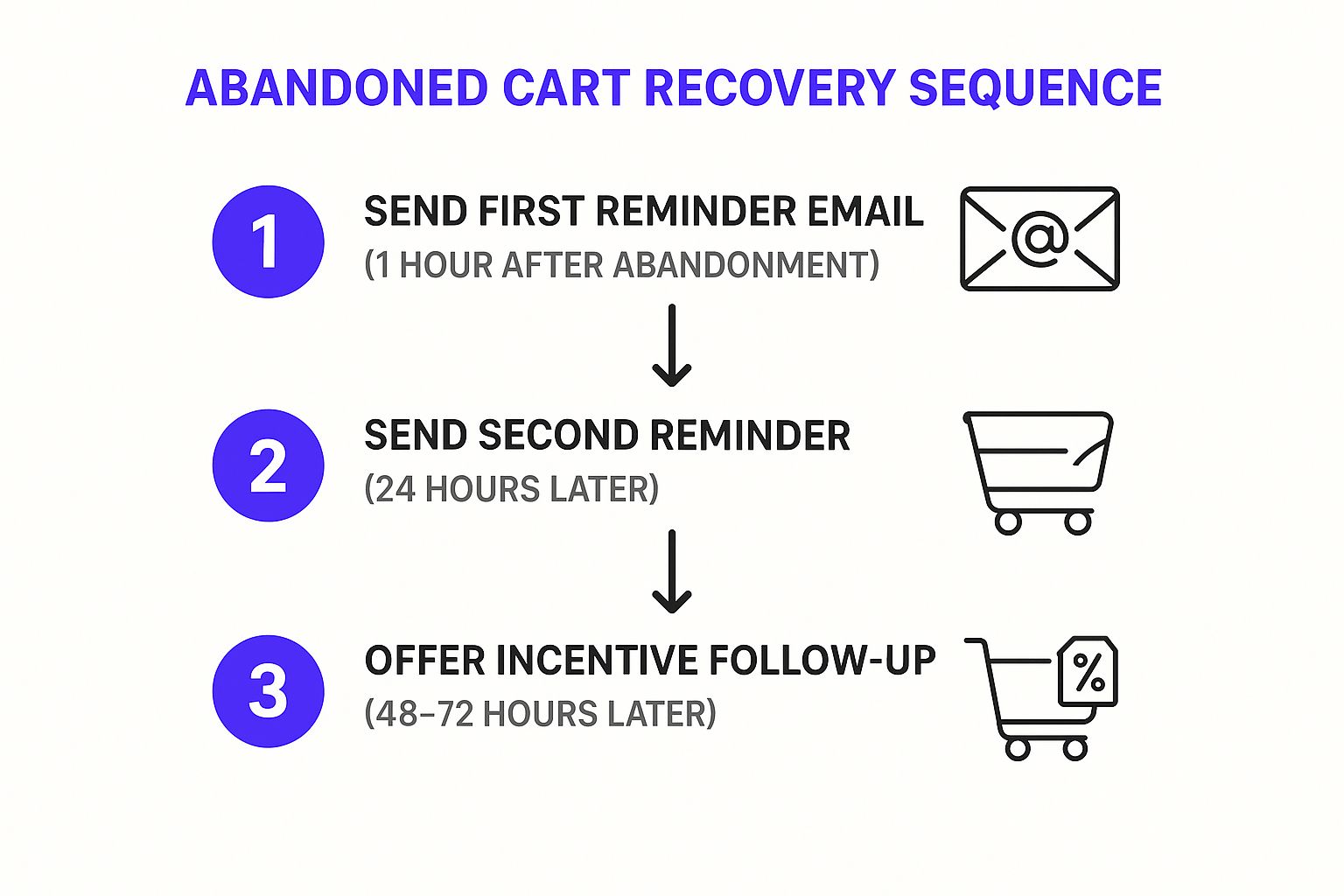
The infographic above illustrates the typical flow of an abandoned cart recovery sequence. It begins with a customer adding an item to their cart and then leaving without purchasing. This triggers the recovery system, which initiates a series of emails or SMS messages designed to entice the customer back. These messages often include reminders of the abandoned items, special offers like free shipping or discounts, and create a sense of urgency. Finally, the infographic shows the two potential outcomes: the customer either returns to complete the purchase or remains inactive. As the infographic clearly shows, a well-implemented abandoned cart recovery system guides the customer back to their purchase, ultimately boosting your conversion rates.
So, how does it work? Abandoned cart recovery systems leverage various features to re-engage potential customers. These include automated email sequences, often with escalating incentives; SMS notifications for mobile shoppers; exit-intent popups offering special deals before a shopper leaves your site; retargeting ads showcasing the abandoned products; on-site notifications when the shopper returns to your store; and persistent cart functionality that saves items across different devices.
For businesses doing $20k-$60k per month or Etsy shops with over $10k in monthly sales, this strategy is especially valuable. You've already attracted these customers and invested in getting them to your site. Abandoned cart recovery maximizes your ROI by focusing on converting this high-intent audience. Imagine an Etsy shop owner recovering even 10% of their abandoned carts - that could translate to an extra $1000 per month!
Examples of Success:
- ASOS recovered 7.9% of abandoned carts through well-timed emails.
- The North Face increased conversions by 8% with personalized cart reminders.
- Dote Shopping recaptured 33% of abandoned carts using SMS notifications.
- Moosejaw recovered $111,000 monthly through abandoned cart automation.
Pros:
- Targets high-intent prospects who've shown a clear interest.
- High ROI compared to customer acquisition tactics.
- Recovers otherwise lost revenue.
- Provides valuable insights into checkout barriers.
- Relatively easy to implement with most e-commerce platforms.
Cons:
- Risk of training customers to abandon carts in anticipation of discounts.
- Potential for communication fatigue.
- Requires a delicate balance between persistence and annoyance.
- Privacy regulations can impact tracking capabilities.
- Effectiveness can vary across product categories and price points.
Actionable Tips to Boost Online Sales with Abandoned Cart Recovery:
- Send the first recovery email within 1 hour of abandonment: Strike while the iron is hot!
- Include product images and direct cart links: Make it easy for customers to return and complete their purchase.
- Test different incentives: Experiment with free shipping, percentage discounts, or bundled offers.
- Create a sequence of 3-4 emails over 48-72 hours: Gentle reminders can be very effective.
- Address common objections: Anticipate and address reasons why customers might abandon their carts (e.g., shipping costs, return policies).
- Segment abandoned cart users based on cart value: Tailor your incentives and messaging.
- Use social proof elements: Include testimonials or reviews in your recovery communications.
Abandoned cart recovery systems are a powerful tool for boosting online sales by targeting warm leads who are already familiar with your products. By implementing these tips and utilizing the features mentioned above, you can significantly increase your conversion rates and recapture lost revenue. Popular platforms like Shopify, Klaviyo, Omnisend, Barilliance, and CartStack offer excellent abandoned cart recovery solutions. Choose the platform that best suits your needs and start recovering those lost sales today!
7 Strategies to Boost Online Sales Compared
Ready to Elevate Your E-commerce Game?
Boosting online sales isn't about luck; it's about implementing the right strategies and consistently optimizing your approach. We've covered seven key tactics to help you achieve just that: Conversion Rate Optimization (CRO), personalized marketing and product recommendations, mobile optimization, social commerce integration, customer retention and loyalty programs, strategic content marketing, and abandoned cart recovery systems. By focusing on these core areas, you can significantly enhance the customer experience, drive more traffic, and ultimately, boost online sales. Mastering these concepts is the key to unlocking sustainable growth and reaching your full e-commerce potential, propelling your business from thousands to hundreds of thousands in monthly revenue. Remember, even small improvements in each of these areas can compound into significant results.
The most impactful takeaway here is that a holistic approach is essential. While each individual tactic offers valuable benefits, the real magic happens when they work together seamlessly. Think of it like a well-oiled machine, with each part contributing to the overall efficiency and power. By implementing these strategies, you're not just increasing sales today—you're building a robust foundation for long-term success and a thriving online business.
Ready to transform your vision into a reality and supercharge your online sales? Wand Websites specializes in helping e-commerce businesses like yours implement these proven strategies. Visit Wand Websites today to learn how we can help you optimize your website, improve customer engagement, and ultimately, boost your online sales.


